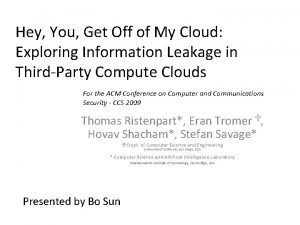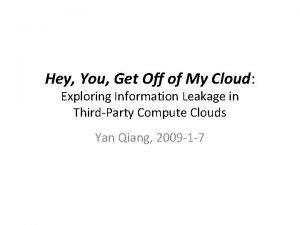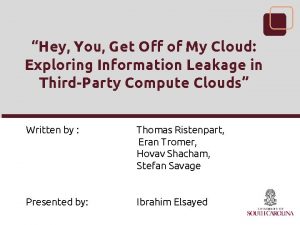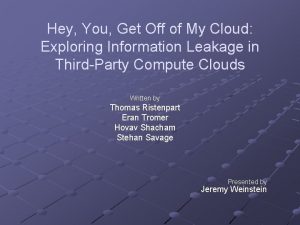Hey You Get Off of My Cloud Exploring





























- Slides: 29

Hey, You, Get Off of My Cloud! Exploring Information Leakage in Third-Party Clouds By Thomas Ristenpart, Eran Tromer, Hovav Shacham and Stefan Savage Presented By: Yugendhar Reddy S

Gist of Today’s Talk Third-party clouds: “cloud cartography” to map internal Infrastructure get malicious VM on same physical server as victim Exploiting a placement vulnerability: only use cloud-provided functionality side-channels might leak confidential data

Third Party Cloud Computing Model User A Virtual Machines (VMS) User B Virtual Machines (VMS) Multitenancy (users share physical resources) Virtual Machine Manager (VMM) manages physical server resources for VMs To the VM should look like dedicated server Owned/operated by cloud provider

Trust models in cloud computing User A Owned/operated by cloud provider User B Users must trust third-party provider to • not spy on running VMs / data • secure infrastructure from external attackers • secure infrastructure from internal attackers

Trust models in cloud computing User A User B Bad Guy Users must trust third-party provider to • not spy on running VMs / data • secure infrastructure from external attackers • secure infrastructure from internal attackers Owned/operated by cloud provider Threats due to sharing of physical infrastructure ? Your business competitor Script kiddies Criminals. . .

Trust models in cloud computing User A Owned/operated by cloud provider User B Bad Guy Attacker identifies one or more victims VMs in cloud Attacker launches VMs 1) Achieve advantageous placement VMs each check for co-residence on same server as victim 2) Launch attacks using physical proximity Exploit VMM vulnerability Do. S Side-channel attack

Using Amazon EC 2 as a case study: 1) Cloud cartography map internal infrastructure of cloud map used to locate targets in cloud 2) Checking for co-residence check that VM is on same server as target - network-based co-residence checks - efficacy confirmed by covert channels 3) Achieving co-residence brute forcing placement instance flooding after target launches 4) Side-channel information leakage coarse-grained cache-contention channels might leak confidential information Placement vulnerability: attackers can knowingly achieve co-residence with target

What our results mean ? given no insider information restricted by (the spirit of) Amazon’s acceptable use policy (AUP) (using only Amazon’s customer APIs and very restricted network probing) Pick target(s) Choose launch parameters for malicious VMs Each VM checks for coresidence Given successful placement, spy on victim web server’s traffic patterns via side channels

Before we get into details of case study: Should Victim panic? No. We didn’t show to extract cryptographic keys But: We exhibit side-channels to measure load across VMs in EC 2 Coarser versions of channels used to extract cryptographic keys Other clouds? We haven’t investigated other clouds Problems only in EC 2? EC 2 network configuration made cartography and co-residence checking easy But: These don’t seem critical to success Placement vulnerabilities seem inherent issue when using multitenancy

Using Amazon EC 2 as a case study: Cloud Cartography Instance Flooding through co-residence checks Placement vulnerability: attackers can knowingly achieve coresidence with target Exploit physical sidechannels Load measurement via side channels • Security Threat seems inherent to any Third Party cloud with mltitenancy • More demands on virtual isolation due to multitenancy • Coarse-grained side channels already of use to some attackers

Co-resident placement 1 or more targets in the cloud and we want to achieve co-resident placement with any of them Suppose we have an oracle for checking co-residence (we’ll realize it later) Launch lots of instances (over time), each asking oracle if successful If target set large enough or adversarial resources (time & money) sufficient, this might already work In practice, we can do much better than this

Some info about EC 2 service (at time of study) Launch parameters • User account • 3 “availability zones” (Zone 1, Zone 2, Zone 3) • 5 instance types (various combinations of virtualized resources) 1 ECU = 1. 0 -1. 2 GHz 2007 Opteron or 2007 Xeon processor Limit of 20 instances at a time per account. Essentially unlimited accounts with credit card.

(Simplified) EC 2 instance networking External domain name External DNS External domain name or IP Internal DNS Intern l P External IP Our experiments indicate that internal IPs are statically assigned to physical servers Co-residence checking via Dom 0: only hop on traceroute to co-resident target Dom 0 Internal routers IP address shows up in traceroutes

Cloud cartography Map internal cloud structure to locate targets Target VM Towards generating a map, we want to understand affects of launch parameters: 1. Availability zone 2. Instance type 3. Account Launch parameters to achieve co-residence

Cloud Cartography From “Account A”: 20 From “Account B”: 20 launch 20 instances of each type in each availability zone x 15 = 300 instances launched launch 20 instances of each type in Zone 3 x 5 = 100 instances launched • 55 of 100 Account B instances had IP address assigned to Account A instance • Seems that user account doesn’t impact placement • Most /24 associated to single instance type and zone • Associate each /24 with Zone & Type 39 hours apart


Achieving co-residence Brute-forcing” co-residence Attacker launches many VMs over a relatively long period of time in target’s zone and of target type Experiment: 1, 686 public HTTP servers as stand-in “targets” running m 1. small and in Zone 3 (via our map) 1, 785 “attacker” instances launched over 18 days Each checked co-residence against all targets Sequential placement Results: locality lowers success 78 unique Dom 0 IPs 141 / 1, 686 (8. 4%)had attacker co-resident Lower bound on true success rate

Achieving co-residence Can an attacker do better? Launch many instances in parallel near time of target launch Exploits parallel placement locality Dynamic nature of cloud helps attacker: • Auto-scaling services (Amazon, Right. Scale, …) Cause target VM to crash, relaunch • Wait for maintenance cycles

Achieving co-residence Can an attacker do better? Launch many instances in parallel near time of target launch Exploits parallel placement locality Experiment: Repeat for 10 trials: 1) Launch 1 target VM (Account A) 2) 5 minutes later, launch 20 “attack” VMs (alternate using Account B or C) 3) Determine if any co-resident with target 4/10 trials succeeded In paper: parallel placement locality good for >56 hours success against commercial accounts

Achieving co-residence

Side-channel information leakage Cache contention yields cross-VM load measurement in EC 2 Attacker measures time to retrieve memory data Read times increase with Victim’s load Measurements via Prime+Trigger+Probe : Extends [OST 05] Prime+Probe technique 1) Read an array to ensure cache used by attacker VM (Prime) 2) Busy loop until CPU’s cycle counter jumps by large value (Trigger) 3) Measure time to read array (Probe)

Load-Measurement Load measurement uses coarse-grained side channel Simpler to mount information More robust to noise Extract less

Cache-based load measurement to determine co-residence Running Apache server 3 pairs of instances, 2 pairs coresident and 1 not 100 cache load measurements during HTTP gets (1024 byte page) and with no HTTP gets Repeated HTTP get requests Performs cache load measurements Instances co-resident Instances NOT co-resident

Cache-based load measurement of traffic rates Running Apache server Varying rates of Web Traffic Performs cache load measurements 3 trials with 1 pair of coresident instances: 1000 cache load measurements during 0, 50, 100, or 200 HTTP gets (3 Mbyte page) per minute for ~1. 5 mins

More on cache-based physical channels Prime+Trigger+Probe combined with differential encoding technique gives high bandwidth cross-VM covert channel on EC 2 Keystroke timing in experimental testbed similar to EC 2 m 1. small instances

More on cache-based physical channels Prime+Trigger+Probe combined with differential encoding technique gives high bandwidth cross-VM covert channel on EC 2 Keystroke timing in experimental testbed similar to EC 2 m 1. small instances VMs pinned to core We show that cache-load measurements enable cross-VM keystroke detection Keystroke timing of this form might be sufficient for the password recovery attacks of [Song, Wagner, Tian 01]

Conclusion- What can cloud providers do? 1) Cloud cartography 2) Achieving Co-residence 3) Side Channel information leakage Possible counter-measures: 1. Random Internal IP assignment 2. Isolate each user’s view of internal address space 3. Hide Dom 0 from traceroutes 4. Random Internal IP assignment 5. Allow users to opt out of Multitenancy (Customers can pay slight extra operation costs to avoid multitenancy) 6. Hardware or software countermeasures to stop leakage References : https: //cse. sc. edu/~huangct/CSCE 813 F 16/CCS 09_cloudsec. pdf https: digitalpiglet. org/teaching

Questions ?

Thank You
 Hey hey you you get off of my cloud
Hey hey you you get off of my cloud Hey hey you you get off of my cloud
Hey hey you you get off of my cloud Get on get off get into get out of
Get on get off get into get out of Song with hey hey hey in chorus
Song with hey hey hey in chorus Song with poetic devices
Song with poetic devices Hey hey bye bye
Hey hey bye bye Hey hey people
Hey hey people Laughing and a running hey hey
Laughing and a running hey hey Can you get high off methocarbamol
Can you get high off methocarbamol Somebody once asked could i spare some change for gas
Somebody once asked could i spare some change for gas Elbows off the table fingers off the food song
Elbows off the table fingers off the food song Defensive end drills
Defensive end drills Laura mulvey male gaze article
Laura mulvey male gaze article Conditionals 0 1 2 3 structure
Conditionals 0 1 2 3 structure Rapporteren voorbeeld
Rapporteren voorbeeld What do you get when you cross darth vader with an elephant
What do you get when you cross darth vader with an elephant Get up get moving quiz
Get up get moving quiz Get up get moving quiz
Get up get moving quiz Get up get moving
Get up get moving Sequence pseudocode example
Sequence pseudocode example Get focused get results
Get focused get results Germer
Germer Hey you
Hey you Hey you
Hey you Selvopretholdelse
Selvopretholdelse Nice to meet you in spanish mucho gusto
Nice to meet you in spanish mucho gusto Hey nice to meet you mucho gusto
Hey nice to meet you mucho gusto Cloud computing refers to
Cloud computing refers to Cloud to cloud integration patterns
Cloud to cloud integration patterns Public cloud vs private cloud cost analysis
Public cloud vs private cloud cost analysis
















































